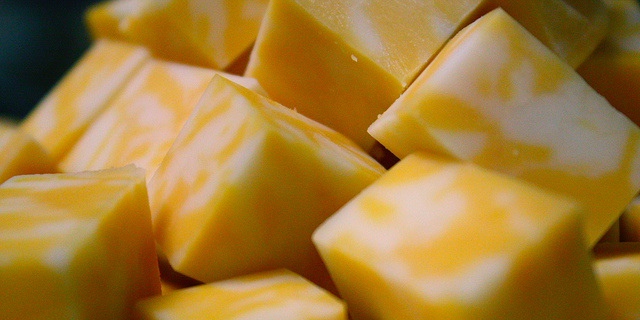It used to be that making cheese meant killing cows. Young cows, specifically — a few days old, at most. The stomach of an unweaned calf produces enzymes that turn liquid milk into good, hard, flavorful cheeses like Parmesan and Cheddar. These enzymes, called rennet, are secreted by mucous membranes that line the calf’s fourth stomach. Harvesting rennet the old fashioned way requires slicing this stomach open, which in turn requires slicing open the baby bovine itself. This, as they say, kills the cow.
Photo Credit: Anne Swoboda CC BY-NC-ND 2.0
For thousands of years, this was how we made cheese. Eventually, calf stomachs became a byproduct of the veal industry. But in the 1970s, America’s growing appetite for cheese collided with its mounting aversion to killing newborn cows. Anticipating a crisis of supply and demand, researchers turned to a then-unprecedented technology in food science: genetically modified organisms. The result was a genetically altered bacterium that produced cheesemaking enzymes in a beaker, instead of an animal’s stomach. This revolutionised the cheese industry. Today, the vast majority of cheese is made with enzymes produced not by baby animals, but genetically modified microbes.
By any measure, the use of GMOs in the production of cheese is among the greatest feats of modern food science. But today, that achievement is often ignored, disowned, and overlooked. At a time when “GMO” is, to many people, a four-letter word, companies like Chipotle are endeavouring to distance themselves from the technology, which they paradoxically depend on.
This is the story of how genetic engineering saved the cheese industry, and how it continues to satisfy one of our biggest culinary cravings in spite of society’s shaky relationship with GMOs.
How The Cheese Got Made
No one knows exactly when or where humans first discovered how to make cheese. Popular legend has it that an Arabian merchant first produced it accidentally, when he found tasty morsels floating in some milk he’d stored in an animal’s stomach. We know that humans living in what is now Poland likely strained their cheese using specialised pottery more than 7,000 years ago. The oldest preserved cheese, which dates to around 1500 BCE, was recently found alongside mummies in an ancient Chinese burial ground. Suffice to say, cheese has been a part of humans’ diets for thousands of years. It transports well, it’s nutritionally dense, and it is, of course, damn delicious.
Some cheeses, like paneer, can be made by heating milk in the presence of an acid like vinegar or lemon juice; but the production of firmer, longer-lasting cheeses requires enzymes that can break down and coagulate milk proteins. Early cheesemakers discovered these enzymes, called rennet, in the fourth stomachs of calves, kids, and lambs. Shortly after they’re born, these ruminants use their rennet to digest their mothers’ milk.
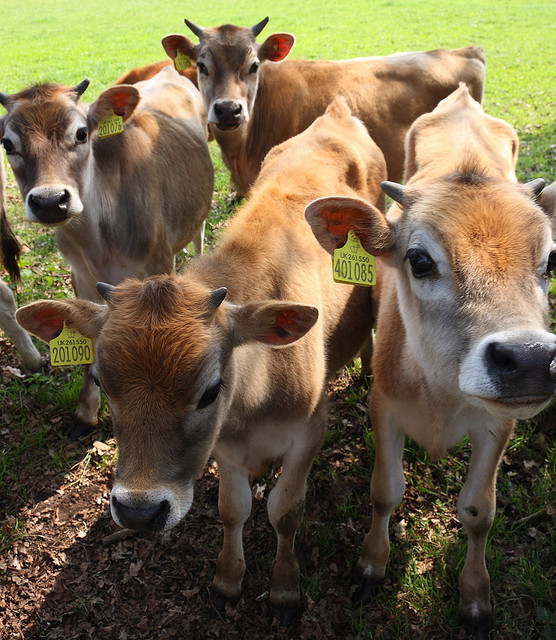
Normally, the fourth stomach stops producing this enzymatic cocktail when the animal graduates to a plant-based diet, so rennet has to be harvested from the organ’s mucosal lining before the animal is weaned. [Photo Credit: Roystan [CC BY-NC-SA 2.0]]
Isolating it is fairly straightforward. Soon after a young calf is slaughtered, its fourth stomach is washed and salted. Some cheese makers cut the salted stomach into small parts, and use them to directly coagulate milk into cheese. Other cheesemakers use salt and vinegar to pull the rennet enzymes out of the stomach into a crude liquid extract (shown in video below), which can also be used to coagulate milk.
Excerpt from BBC’s 2009 Documentary, Victorian Farm, showing how animal rennet is traditionally made.
Isolated rennet helps turn milk into hard cheeses, which, unlike milk, can be carried over vast distances, unchilled, without spoiling. For thousands of years, the ability to store and transport cheese without a refrigerator made it an ideal food for merchants and travellers around the world.
In the 19th century, a growing demand for cheese, combined with the industrialisation of agriculture, spurred cheese makers to move from farms to factories. Industrial output escalated. By the turn of the century, factory cheese production had rendered farm-produced cheese insignificant. By 1920, American factories were producing 418-million pounds of cheese annually; by 1970, the rate had risen to 2.2-billion pounds per year.
The cheese business was booming. But if it was going to continue growing, cheesemakers were going to need a lot more baby cows.
A Recipe For Disaster: Cheese Boom And Veal Bust
A lot of dairy goes into cheese production — about ten ounces of milk for every ounce of cheese. But a single, mature dairy cow can produce up to 20,000 pounds of milk annually. A typical cow is a member of its dairy herd for five years, though many remain productive for more than a decade. One cow, in other words, can generate enough milk to net you five tons of cheese over the course of its lifetime.
Rennet, by comparison, can only be obtained once from a single, young animal. This makes it a costly necessity during cheese production. To make billions of pounds of cheese, industrial chemistry is needed to produce large quantities of rennet. Recently harvested calf stomachs are chopped up en masse, and then chemically refined to produce rennet consisting of precise ratios of various enzymes, such as chymosin and pepsin, which are needed for consistent cheese production.
If a calf is already destined to become veal, one could argue that collecting its rennet isn’t a waste. By the 1970s, however, the demand for meat in general had also risen, making adult cattle a better investment than calves. Moreover, the concept of animal rights was gaining traction. The veal industry, in particular, served as a lightning rod for criticism, even from people outside of growing vegetarian circles. As demand for veal plummeted, more and more meat suppliers opted to let their cows grow up before being slaughtered.

Above: The Tillamook cheese factory in Tillamook, Oregon. Photo Credit: James Yu | CC BY-NC-SA 2.0
The supply of rennet dropped, leaving cheesemakers in a bind. They could pay top dollar for what rennet was still being produced, but this option had little long-term viability in a market hungry for billions of pounds of cheese. They could resort to alternative cheesemaking enzymes (various fungi and plants also produce enzymes that can make cheese from milk), but the resulting cheeses weren’t adequately tasty.
Or perhaps, with some luck, cheese makers could diverge from thousands of years of tradition, and come up with a better source of high-quality, milk-coagulating enzyme than calf stomachs.
Genetic Engineering To The Rescue
While the cheese industry scrambled for a new source of rennet-like enzymes, biology, medicine, and even agriculture were being transformed by the advent of genetic engineering. In 1982, Genentech earned approval from the U.S. Food and Drug Administration for the medical use of insulin produced by genetically modified microbes. It was more than a boon for medicine — it also showed that GMOs were a viable substitute for animals in the production of pure proteins. (Injectible insulin originally came from refined animal pancreases.) It stood to reason a similar technique could be used to produce the key enzyme in rennet.
Previous studies had shown that an enzyme called chymosin was responsible for most of rennet’s milk-coagulating properties. It would be easier, and more cost-effective, to produce mass quantities of chymosin in a laboratory than to harvest it from the stomachs of young calves — especially in light of the veal shortage. So companies began experimenting with inserting the chymosin gene into microbes.
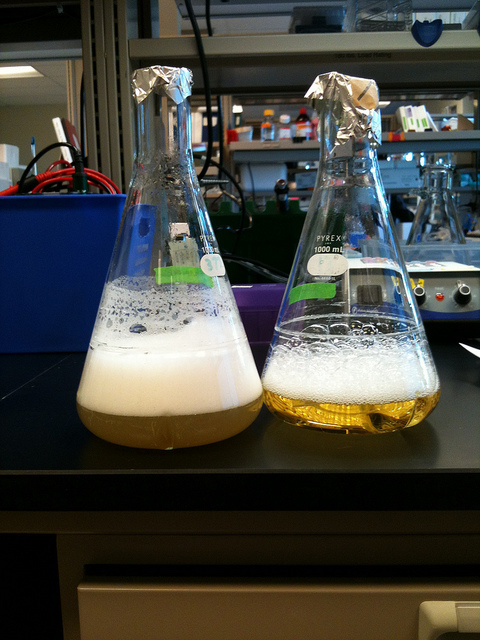
In the late ’80s, scientists at Pfizer successfully inserted the calf chymosin gene into Escherichia coli. This transformed the bacteria into chymosin-synthesizing powerhouses; the genetically modified E. coli strain could generate large quantities of the mammalian enzyme in the absence of the animals themselves. In 1990, the FDA approved Pfizer’s GMO-derived chymosin for human consumption, on the basis that it was identical to the chymosin found in animal rennet. It was the first artificially produced enzyme to be registered and allowed by the FDA. Moreover, virtually none of the genetically-modified bacteria used to produce the chymosin remained in Pfizer’s purified product. [At left: Transgenic E. coli ferments in a culture flask. The flask on the left had growth, while the other had little. Photo Credit: James Yu via flickr [CC BY 2.0]]
In fact, the chymosin derived from GMOs was more pure than animal rennet. Called Fermentation-Produced Chymosin (FPC), it produced a more consistent cheese with less waste than an equivalent amount of crude calf stomach extract. FDA approval of Pfizer’s FPC meant the cheese industry no longer had to depend on the veal industry. It marked the beginning of a new era of cheese manufacturing.
Our Complicated Relationship With “GMO” Cheese
Today, it is estimated that 80 — 90% of cheese in the US and UK is made using FPC. The GMO-derived enzyme has been a boon for cheese manufacturing and cheese sales. The US produced about 11-billion pounds of cheese in 2013 alone, thanks in large part to the cost-effectiveness of FPC. The technology has transformed the industry, making it more efficient, more environmentally friendly, and less dependent on animals. It has also fanned the flames of our addiction; today, the average American eats thirty-three pounds of cheese per year, nearly three times the 1970s rate.
But FPC is especially interesting for the divisive role it plays in contemporary debates over the safety of genetic engineering, and the labelling of GMO foods. Most cheese is produced with FPC synthesized by genetically modified microbes. Should consumers be made aware of this? If so, how should they be made aware? It’s not as though the cheese itself is genetically modified. Neither is the chymosin that produces the cheese. Chymosin is a protein and therefore contains no genetic material. Any genes found in purified FPC would be present only in trace amounts, vestiges of whatever genetically modified microbe produced the chymosin.
Cheesemakers know this line of reasoning well. Chr. Hansen, a Danish company, manufactures of some of the most popular brands of FPC in the world. The company describes its FPC as “GMO-free,” because purified FPC contains little to no trace of the genetically modified fungus, Aspergillus niger, that produces it. (But because organic food cannot even be a byproduct of GMOs, Chr. Hansen states that its GMO-free FPC is not acceptable for organic cheese production.) Similarly, Tillamook, an Oregon-based dairy company, uses FPC for all but five of its dozens of cheese varieties. Tillamook representatives recently stated on the company’s blog that “after purification, the end [FPC] rennet product does not contain any genetically modified material, since it no longer contains DNA from the cow gene. It is considered non-GMO by U.S. food industry standards.”
Cheese, in other words, may be an unambiguous product of genetic engineering, but it is two steps removed from the genetically modified organism responsible for its existence. This raises difficult questions for consumers and companies with a taste for cheese and a distaste for GMOs. Is it right to love the sinner, but hate the sin?
Consider Chipotle. Last year, Kevin Folta, chair of the Horticultural Sciences Department at the University of Florida, publicly inquired whether Chipotle uses cheese made with animal rennet or GMO-derived FPC. Chipotle responded that its cheese is produced using “an FPC rennet that is not GMO.” If you’re familiar with the cheese industry’s reliance on GMOs, Chipotle’s answer comes across as pretty mealy-mouthed.
Folta told me that Chipotle never clarified its opaque response to his question. Folta questioned why soybean oil, made from GMO soy plants, was publicly eliminated by Chipotle on the basis of its GMO origins, while cheese made using GMO-derived FPC got a free pass. One might argue that cheese made using FPC is one step further removed from its GMO microbe than soybean oil is from GMO soy plants. Nevertheless, a GMO byproduct, and not the GMO itself, remains in both final products.
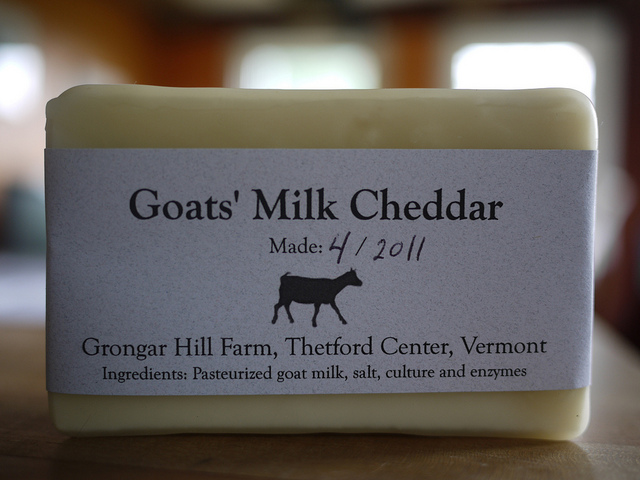
Rebecca Siegel CC BY 2.0
It’s useful to have debates about the role of technology in our food supply, but GMO FPC has clearly changed the cheese industry for the better. Culturing microbes in a lab to make FPC is better for the environment than raising animals to make rennet, and chymosin is easier to purify from microbes than from animal organs. It’s safe to assume that even though Chipotle claims to have gone GMO-free, the FPC used to make its cheese is still sourced from GMOs, just like the sugar in its sodas, and the feed used to raise its meat.
What Cheese Do You Eat?
If you’re a vegetarian, your best bet is to eat cheeses made with FPC. If you’re anti-GMO, you’re better off eating cheese labelled “organic,” as these cheeses are made with either calf rennet, or lesser-quality plant or microbial enzymes. If you’re vegetarian and anti-GMO, your options are pretty limited.
I spoke via email with Michael Jensen, the Global Marketing Manager of Chr. Hansen, and he stated that good cheese is generally made with either FPC or calf rennet. Alternatives to either form of chymosin may satisfy a moral hunger, but not a foodie’s tastebuds: “The main challenges with non-chymosin products are, among others, bitterness, faster texture degradation and lower cheese output,” he says.
For good organic cheese, and many of the highly-regulated, famous cheeses of France and Italy, animal rennet is the go-to enzyme, though “FPC-based cheeses do compete very well,” according to Jensen. However, animal rennet must come from unweaned calves. If you are vegetarian, FPC-based cheeses are probably the way to go. FPC is often labelled as “vegetarian rennet,” though some vegetarians may take issue with the origin of FPC microbe strains, which involved the one-time insertion of animal DNA into those microbes. Further confusing the issue, FPC can also be labelled as “vegetable rennet” (the microbes that produce FPC thrive on vegetable-based nutrients), or “microbial rennet” (which could either refer to FPC, or to the lesser enzymes that are naturally found in other microbes).
There’s no way around it: if you want to know exactly how your cheese was made, you may need to do more than a little digging – and you might run into the same ambiguities that Folta encountered with Chipotle. FPC may not contain any GMOs, but GMOs are the key to producing FPC.
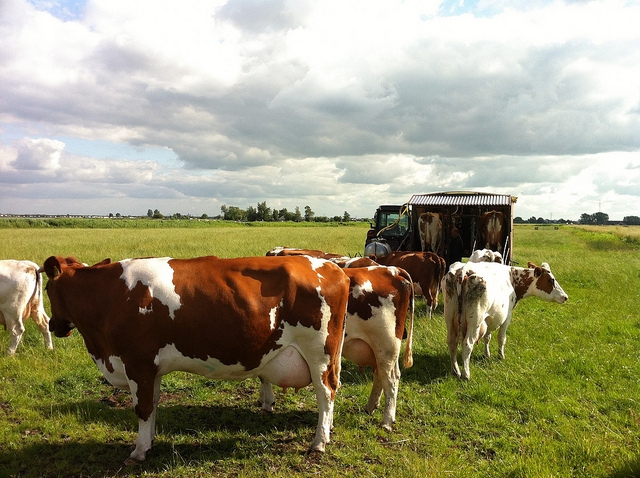
Tim Lucas CC BY 2.0
Lastly, if you find the milk that goes into cheese is itself bothersome from an animal rights standpoint, rest assured that scientists are currently attempting to recreate the biosynthesis of cow’s milk in GM microbes. Real Vegan Cheese is a startup that aims to produce cheese exclusively with GMOs. Some vegan groups have pushed back against the vegan movement’s broad opposition to GMOs, in recognition that GMOs could make food production less dependent on animal lives. Regardless, it will be some time before we successfully source cow’s milk from the lab.
It’s up to you whether you consider FPC to be a GM food, vegetarian, or just a modern solution to an old problem, but it is undeniable that using genetically engineered microbes to make FPC has saved countless animal lives while keeping the cheese industry afloat. For that, we should be grateful.
Correction: This piece originally misstated that cheesemakers in Denmark cannot use FPC due to local GMO regulations. Some Danish cheesemakers do, in fact, use FPC as their primary milk coagulating enzyme, though Danish policy does dictate that FPC cannot be used for organic cheeses.
